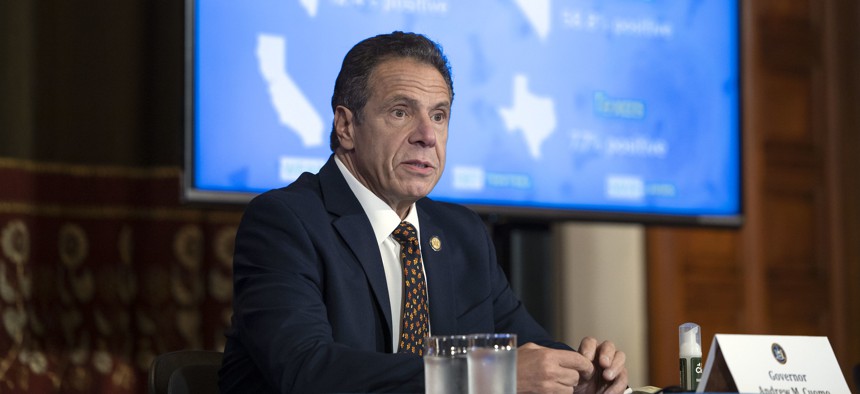New York State
Assembly impeachment report details how Cuomo undermined COVID-19 response
The former pandemic star sidelined health officials while devoting state resources to writing a lucrative pandemic memoir.

Despite all the accolades Andrew Cuomo has gotten for managing COVID-19, the newly-released Assembly report highlights how his leadership style undermined the state response to the pandemic. Mike Groll/Office of former Governor Andrew M. Cuomo
A report released by the Assembly Judiciary Committee Monday details a range of alleged wrongdoing by former Gov. Andrew Cuomo. He sexually harassed staff, hid data showing the true extent of COVID-19 among nursing home residents and used state resources to ink a multimillion dollar book deal.
The 60-page report also highlights how Cuomo arguably mismanaged the coronavirus – the source of his former fame as a national hero against the pandemic.
Cuomo’s handling of the public health crisis has been cited by his supporters as one reason why New Yorkers should withhold judgement on a range of alleged misconduct. The newly-released Assembly report, however, includes new revelations about how his leadership style undermined the state response to the coronavirus in the first months of the pandemic. And more than a few longtime Cuomo critics are already saying they told everyone so long ago. “@andrewcuomo refused to act for days, literally and demonstrably costing lives while spending energy & resources on a book on Leadership,” New York City Public Advocate Jumaane Williams, a 2022 gubernatorial candidate and longtime critic of Cuomo’s approach to COVID-19, tweeted Monday. “Also frustrating are the leaders who remained silent, refusing to stand up to his deadly decisions on behalf of New Yorkers.”
One way the report showed Cuomo falling short on combating COVID-19 was by noting the lack of health care expertise on the task force he named, which included lots of longtime political allies. An unnamed “senior DOH official” – who appears to be the outgoing health commissioner Dr. Howard Zucker – was the only healthcare professional and that suggests a lack of epidemiological expertise on the task force. “That senior DOH official did not have regular meetings with (Cuomo) during the pandemic," reads the report. The unnamed official reportedly felt Cuomo was disregarding advice from experts while micromanaging the state response, a leadership trait Cuomo indulged long before the pandemic. This is consistent with other recent revelations of how Cuomo micromanaged the state response to the arguable detriment of the state. Investigative transcripts released by state Attorney General Letitia James, for example, show how the Cuomo administration blocked local and state health officials from coordinating their efforts.
There have already been damning reports on alleged sexual misconduct and the nursing home issue, but the Assembly report was the first to delve into the details of the multi-million dollar book deal that Cuomo announced in August 2020. A book publisher first approached him about writing about his pandemic experiences even before he had officially relented on issuing a stay-at-home order in March. A literary agent told the publisher about 70,000 words were ready by July 1. The book effort took a significant amount of state resources, including time when what the report calls distracted gubernatorial staffers who were supposedly on the clock. Long story short – the supposedly straight-talking communicator was personally involved in hiding data showing how many nursing home residents died in hospitals of COVID-19 while he was busy writing the book, according to the report. So add that to the litany of sources contradicting Cuomo’s efforts to project how he was giving the facts to New Yorkers straight when it came to COVID-19.
The report is not all bad for Cuomo. Assembly investigators found nothing to contradict the idea that people like unwitting nursing home staff were likely responsible for introducing the coronavirus to many facilities rather than a controversial March 25, 2020 executive order. There was nothing in the report to substantiate outstanding safety concerns on the bridge he named after his father. For what it is worth, some Assembly members might be living in glass houses when it comes to making staffers do volunteer work on their behalf in a state Capitol where staffers are often pushed to do things outside normal work hours, as a spokesperson for Cuomo notes in a press release responding to the report, which claims that the Assembly report is just a “flawed” piece of work.
Much of his erstwhile pandemic renown came from the daily (formerly-Emmy-winning) press briefings he delivered in the months immediately after the first case of COVID-19 was confirmed in New York at the beginning of March 2020. Millions of people across the country saw Cuomo as a steady hand at a time when then-President Donald Trump was downplaying the severity of the pandemic. The governor looked into the cameras, promised to follow the science, lean on the best people and tell New Yorkers what was really happening. “Don't think of just yourself,” Cuomo advised New Yorkers in a March 18 podcast posted by The New York Times. “Save as many lives as you can. Be responsible. Be civic-minded. Be kind. Be considerate.”
The number of people who believe the governor is the victim of a political witch hunt appears to be getting smaller despite efforts by his political allies. Members of the Assembly largely confirmed details about alleged sexual misconduct and the nursing home cover-up while expanding public knowledge about the book deal that Cuomo signed. Its October 2020 release came when Cuomo was still riding high with pandemic fame. He would lose that over the following year along with the Emmy he once won. The one-time “master of disaster” is now lost somewhere in the political wilderness and the new Assembly report suggests he will have one heck of a time staging that rumored comeback anytime soon by running on a pandemic record that increasingly looks pretty bad in retrospect.

NEXT STORY: Impeachment investigators release their report on Cuomo

